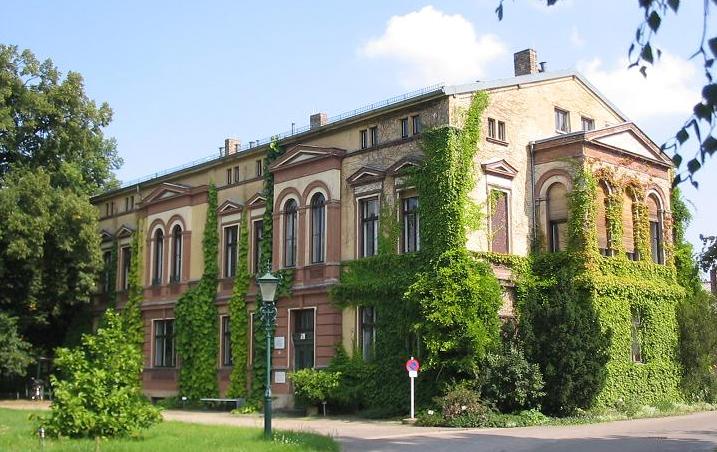Späth-Arboretum on:
[Wikipedia]
[Google]
[Amazon]


 The Späth-Arboretum (3.5 hectares) is an
The Späth-Arboretum (3.5 hectares) is an
Humboldt-Universität zu Berlin: Späth-Arboretum
Garden map
Hermann von Helmholtz-Zentrum entry
Berlin.de entry
{{DEFAULTSORT:Spath-Arboretum Arboreta in Germany Gardens in Berlin Treptow-Köpenick
arboretum
An arboretum (plural: arboreta) in a general sense is a botanical collection composed exclusively of trees of a variety of species. Originally mostly created as a section in a larger garden or park for specimens of mostly non-local species, m ...
now maintained by the Humboldt University of Berlin
The Humboldt University of Berlin (german: link=no, Humboldt-Universität zu Berlin, abbreviated HU Berlin) is a public university, public research university in the central borough of Mitte in Berlin, Germany.
The university was established ...
. It is located at Späthstraße 80/81, Berlin
Berlin is Capital of Germany, the capital and largest city of Germany, both by area and List of cities in Germany by population, by population. Its more than 3.85 million inhabitants make it the European Union's List of cities in the European U ...
, Germany
Germany, officially the Federal Republic of Germany (FRG),, is a country in Central Europe. It is the most populous member state of the European Union. Germany lies between the Baltic and North Sea to the north and the Alps to the sou ...
, and open several days per week in the warmer months.
About
The arboretum was begun in 1879 by Franz Ludwig Späth, owner of the world's largest and oldest tree nursery (Späth nursery The Späth (often spelt ''Spaeth'') family created one of the world's most notable plant nurseries of the 19th and early 20th centuries. The nursery had been founded in 1720 by Christoph Späth but removed to the erstwhile district of Baumschulenwe ...
, founded 1720), when he expanded the garden around his 1874 villa. Berlin city gardener Gustav Meyer
Gustav Meyer (25 November 1850 – 28 August 1900) was a German linguist and Indo-European scholar, considered to be one of the most important Albanologists of his time, most importantly by proving that the Albanian language belongs to the Ind ...
designed the arboretum in the style of an English garden
The English landscape garden, also called English landscape park or simply the English garden (french: Jardin à l'anglaise, it, Giardino all'inglese, german: Englischer Landschaftsgarten, pt, Jardim inglês, es, Jardín inglés), is a sty ...
. On Franz's death in 1913, ownership passed to his son Hellmut, who added a rock garden
A rock garden, also known as a rockery and formerly as a rockwork, is a garden, or more often a part of a garden, with a landscaping framework of rocks, stones, and gravel, with planting appropriate to this setting. Usually these are small ...
to the centre in 1928. The first arboretum catalogue published in 1930 listed almost 4,500 taxa
In biology, a taxon ( back-formation from '' taxonomy''; plural taxa) is a group of one or more populations of an organism or organisms seen by taxonomists to form a unit. Although neither is required, a taxon is usually known by a particular n ...
.
Hellmut was executed in Sachsenhausen in 1945; ownership passed to a trust in 1947, and then to the people in 1949. When the university's Institute for Special Botany was created, it was given the villa and arboretum as its home in 1961. In 1966 the grounds were opened to the public four Sundays a year for concerts, a tradition which continues to this day. In 1969 the institute became affiliated with the university's Museum of Natural History, and in 1981 a series of six postal stamps entitled "Rare trees from the Arboretum" was issued.
Today the arboretum contains more than 1,200 exotic trees and bushes from Asia
Asia (, ) is one of the world's most notable geographical regions, which is either considered a continent in its own right or a subcontinent of Eurasia, which shares the continental landmass of Afro-Eurasia with Africa. Asia covers an ...
, Africa
Africa is the world's second-largest and second-most populous continent, after Asia in both cases. At about 30.3 million km2 (11.7 million square miles) including adjacent islands, it covers 6% of Earth's total surface area ...
, and America
The United States of America (U.S.A. or USA), commonly known as the United States (U.S. or US) or America, is a country primarily located in North America. It consists of 50 states, a federal district, five major unincorporated territor ...
for research and display. Its total holdings include about 4,000 plant species
In biology, a species is the basic unit of Taxonomy (biology), classification and a taxonomic rank of an organism, as well as a unit of biodiversity. A species is often defined as the largest group of organisms in which any two individuals of ...
with a systematic collection of herbaceous
Herbaceous plants are vascular plants that have no persistent woody stems above ground. This broad category of plants includes many perennials, and nearly all annuals and biennials.
Definitions of "herb" and "herbaceous"
The fourth edition ...
plants, medicinal and aromatic garden, and rock garden.
See also
*Botanical Garden in Berlin
The Berlin Botanic Garden and Botanical Museum (german: link=no, Botanischer Garten und Botanisches Museum Berlin) is a botanical garden in the locality of the borough of , Berlin, Germany. Constructed between 1897 and 1910 under the guidance ...
* List of botanical gardens in Germany
This is a list of botanical gardens in Germany. This list is intended to contain all significant botanical gardens and arboreta in Germany.
List
See also
* List of botanical gardens
References
Zentralregister biologischer Forschungssammlun ...
External links
*Humboldt-Universität zu Berlin: Späth-Arboretum
Garden map
Hermann von Helmholtz-Zentrum entry
Berlin.de entry
{{DEFAULTSORT:Spath-Arboretum Arboreta in Germany Gardens in Berlin Treptow-Köpenick